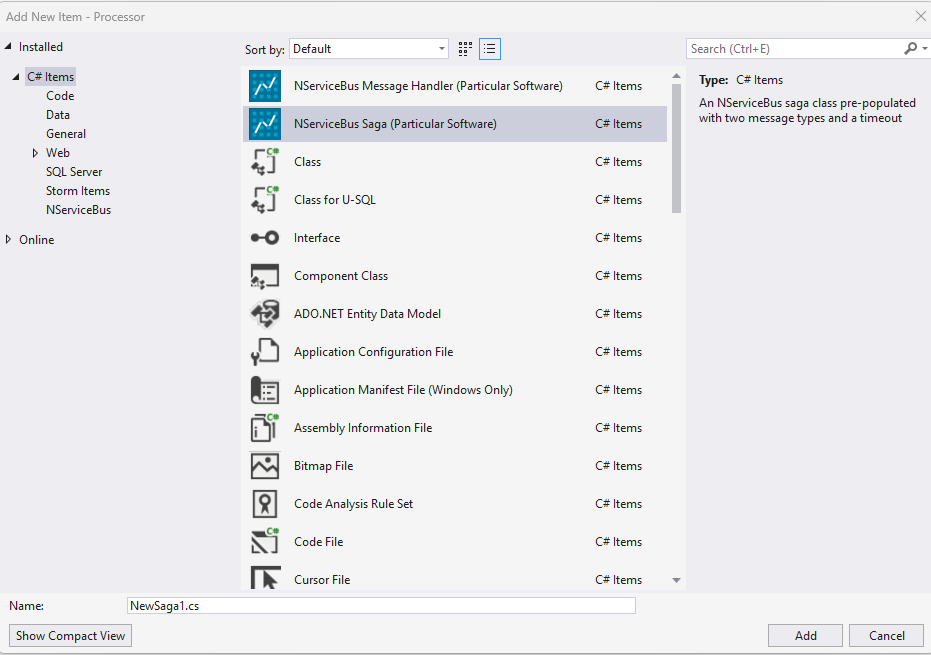The Particular dotnet new templates make it easier to bootstrap a variety of common project and code-related scenarios.
The dotnet new command creates a new project, configuration file, or solution based on the specified template. The command provides a convenient way to initialize a valid SDK-style project. The command calls the template engine to create the artifacts on disk based on the specified template and options. More information is available in the dotnet-new documentation.
Installation
Install using the following command:
// install latest version
dotnet new install ParticularTemplates
If a specific version is needed, follow the guidance in the dotnet new install documentation.
NServiceBus Endpoint
The nsbendpoint template creates a C# project for an NServiceBus endpoint. By selecting options, the endpoint is preconfigured with choices of:
- Target framework
- Message transport
- Persistence
- Hosting model, which can be one of:
- Console Application
- Windows service hosting
- Docker container hosing
Once the package is installed, the template can be found in the Visual Studio New Project dialog:

After naming the project and selecting a location for it on disk, the Additional information screen will allow customizing the template:

Command-line usage
The default usage will create a Console Application using Learning Transport, Learning Persistence:
dotnet new nsbendpoint --name MyEndpoint [options]
dotnet sln add "MyEndpoint/MyEndpoint.csproj"
Parameters allow the selection of message transport, persistence, and hosting model, including Windows Service or Docker container hosting.
Options
| Option | Description |
|---|---|
-n,--name | The name of the endpoint to create. |
-f,--framework | The target framework for the project. One of: net8., net7. (default), net6., net48, net472 |
-t,--transport | The message queue (transport) to use. One of LearningTransport (default), AzureServiceBus, AzureStorageQueues, SQS, RabbitMQ, SQL. |
-p,--persistence | Where to store data. This should be the same place business data is stored. One of LearningPersistence (default), MSSQL, MySQL, PostgreSQL, Oracle, CosmosDB, AzureTable, RavenDB, MongoDB, DynamoDB |
-hm,--hosting | The hosting model to use. One of: ConsoleApp (default), WindowsService, Docker |
For more details on available options and choices, use this command to get help:
dotnet new nsbendpoint --help
NServiceBus Handler
The nsbhandler item template creates a C# class for a message handler.
Message handlers can be created using the Visual Studio New Item dialogue or the command line.

To create a message handler class that implements IHandleMessages:
dotnet new nsbhandler --name ClassName --messagetype MyMessage
Options
| Option | Description |
|---|---|
-n,--name | The name of the message handler class to create. |
-mt,--messagetype | The message type for the handler to implement. Default: MessageType |
For more details on available options and choices, use this command to get help:
dotnet new nsbhandler --help
NServiceBus Saga
The nsbsaga item template creates a C# class for a saga that includes the saga class, saga data class, handlers for two message types, a custom timeout class, and the ConfigureHowToFindSaga method.
Message handlers can be created using the Visual Studio New Item dialogue or the command line.

To create a saga:
dotnet new nsbsaga --name ClassName --messagetype1 Message1 --messagetype2 Message2
Options
| Option | Description |
|---|---|
-n,--name | The name of the saga class to create. |
-mt2,--messagetype | The first message type that will be handled by the saga. Default: MessageType1 |
-mt1,--messagetype | The second message type that will be handled by the saga. Default: MessageType2 |
For more details on available options and choices, use this command to get help:
dotnet new nsbsaga --help